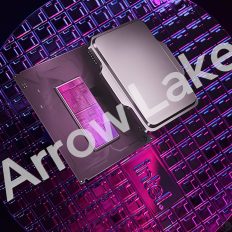Intel has achieved "Power On" with its next-gen Panther Lake CPUs that utilize the 18A process node and are coming to several segments with improvements across the board.
Intel's Panther Lake Achieves Power-On With 18A Process Node, Engineering Team Now Gunning For IPC Improvements Versus Clock Speed Bumps
During their keynote, Intel's CEO, Pat Gelsinsger, announced that the next-gen Panther Lake CPUs are on track and have achieved "Power On" status which is a crucial milestone in the development of chips. Pat held a wafer of the Panther Lake CPUs during the keynote which uses the 18A process node, marking a major step from the TSMC-based Lunar Lake to the in-house Panther Lake design.
So far, we have only seen rumors that the next-gen cores for Panther Lake will be known as Cougar Cove on the P-Core and an enhanced version of Skymont on the E-Core side. The ones being used by the next-gen Clearwater Forest are called Darkmont. While the company isn't going into any specifics on Panther Lake, the recent Tech Tour gave us some insight into how Panther Lake will mark a radical shift from the existing engineering mindset.

It was revealed during a Q&A session that Intel states that there are two ways to do chips, you either invest in making significant changes to the architecture or just use high-frequency as your model. The latter is more difficult and takes a lot more time so starting with Lunar Lake, Intel has learned that it will be a wiser decision to just go the first route which is to introduce architectural changes for its next-gen chips. The microarchitecture development model also brings a lot more power efficiency to the table so in future chips following Lunar Lake, it's going to be all about going after IPC.
The architecture strategy has been to focus on instructions per cycle improvements this is micro-architectural improvements. You can typically think when you are doing CPUs on how much time you want to spend doing microarchitecture has a lot of interesting challenges because you are looking at different pipelines, cache sizes, instructions like this or you just spent your time on tight enclosure and if you have really high frequency as your model then it takes a lot more time so we have been shifting our time towards the microarchitecture because that's where you get a lot more power efficiency. This is one of our first major steps for Lion Cove which is our CPU here, Skymont E-Core, every generation after is the same thing, go after IPC, IPC, IPC.
Intel
Intel also stated that Panther Lake will be a very flexible and scalable design. The flexibility being discussed is regarding memory. You've seen that Lunar Lake comes in either 16 GB or 32 GB on-package chip flavors but with Panther Lake, we are going to see a scale-up across the board. Intel didn't specify what sort of memory upgrades we will get but we will surely get them
Panther Lake has a lot more memory flexibility, different memory flexibility options and we can scale it across, whether you say a typically 15W TDP or higher. With Lunar Lake, we wanted to have the one major mobile-optimized product to really get a goods architecture in good shape and then scale it so sort of like the first step is to get the architecture and the next step is to scale it. And the scale would include a lot more flexibility for thermal design points and memory technologies.
For the next generation, we will take our time to scale it up because we are going to support several segments.
Intel
Not just that, Intel will be scaling up Panther Lake CPUs massively to support several segments. Panther Lake isn't going to be a 2nd Gen Lunar Lake, it's going to come to all segments including mobile and desktops. So that's a great thing to hear and it's all because of the lessons learned when designing Lunar Lake.
Intel's Panther Lake CPUs are expected to go into production on the 18A process node in the first half of 2025 with the availability of the first chips planned for 2H 2025. So there's still some time before we get to see those chips in action but Lunar Lake and Arrow Lake CPUs will be offering a great set of innovations on their respective platforms for the meanwhile.
Intel Process Roadmap
| Process Name | Intel 14A-E | Intel 14A | Intel 18A | Intel 20A | Intel 3 | Intel 4 | Intel 7 | Intel 10nm SuperFin |
|---|---|---|---|---|---|---|---|---|
| Production | 2027 | 2026 | 2H 2024 | 1H 2024 | 1H 2023 | 2H 2022 | In Volume (Now) | In High-Volume (Now) |
| Perf/Watt (over 10nm ESF) | TBA | TBA | TBA | >20%? | 18% | 20% | 10-15% | N/A |
| EUV | TBD | High-NA EUV | Yes | Yes | Yes | Yes | N/A | N/A |
| Transistor Architecture | TBD | TBD | Optimized RibbonFET | RibbonFET | Optimized FinFET | Optimized FinFET | Optimized FinFET | FinFET |
| Products | TBD | TBD | Nova Lake Panther Lake Clearwater Forest Diamond Rapids? Foundry Partner | Lunar Lake Arrow Lake Diamond Rapids? | Granite Rapids Sierra Forest Foundry Partner | Meteor Lake Xe-HPC / Xe-HP? | Alder Lake Raptor Lake Sapphire Rapids Emerald Rapids Xe-HPG? | Tiger Lake |





